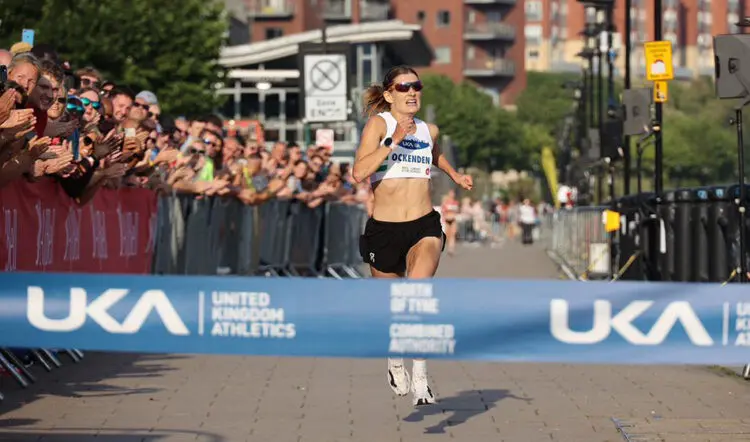Verity Ockenden writes about why we should expect more “veteran” athletes to be challenging at the top level in future – and why that can only be good for the sport .
The subject of ageing has been playing on my mind more than I’d like to admit recently. I turned 34 in August and, for the first time in my life, I felt uncomfortable about having a birthday – and then even more uncomfortable with myself for feeling uncomfortable about it.
I’m sure I only felt this way because of the way age is perceived in the industry I work in, where traditionally athletes are believed to have seen their best days by the time they hit 30. I knew that, based on my own data, at four whole years past my “sell-by” date, my body has been capable of producing consistently better splits in training that I had ever dreamt of previously. And yet I couldn’t shake the feeling that, alongside all of the other hurdles that come with being a professional athlete, maybe I would also be swimming against a tide of common opinion strongly biased against me in the years to come.
I had seen articles written in the build-up to the World Championships that celebrated the longevity of the likes of Shelly-Ann Fraser-Pryce and Emily Infeld, who would both be competing in Tokyo, but it still shocked me to hear them being referred to as veterans at the ages of 38 and 35 respectively. Technically, this is the correct terminology according to the rulebook, but I’m wondering if it is about time that the rulebook got updated (and this isn’t just a bad case of Dorian Gray syndrome speaking).

While there are of course differences in the sustainability of various types of physical impact and expected longevity across disciplines – sprinters are comparatively not expected to maintain their speed for as many years as a distance athlete might be able to maintain their endurance – Shelly-Ann has showed that not only can you be the best 100m sprinter in the world at 35 (in Eugene 2022) but at 38 you can also still be in the top six, and only 0.19 from winning at a global championships. As she walked away from the track and from the last performance of her illustrious career, it was clear that she was retiring very much out of personal choice rather than physical limitation.
Emily came into these World Championships having won the US 10,000m Championships with a sharp kick that clearly demonstrated an absence of decline in her fast twitch fibres, and while she admits that she has changed her training approach to accommodate her body’s evolving requirements in order to achieve the same level of results over the years, she finds herself just as fast and capable as she was ten years ago.

Particularly in the distance events, there are so many shining examples of women over 35 learning how to get the very best out of themselves on both the track and the roads with the benefit of experience behind them just like Emily.
Britain’s very own Jo Pavey is a classic example, having secured the most prestigious win of her career with a European 10,000m gold at almost 41 years of age. Echoing this pattern, I was delighted to see Ireland’s Fionnula McCormack place ninth at the World Championships marathon – again, the best global finish of her career – just shy of 41 years old.
You might wonder why so far I’ve only been talking about women, and this is an omission that isn’t lost on me. As I wrote this, I realised that I hadn’t heard much talk about any of the “veteran” male athletes competing in Tokyo, and I began to wonder whether there were any or whether it just wasn’t being reported on in the same way, and if so, why?

Was it less of a big deal for men to continue to compete into their forties or were fewer male athletes actually managing to achieve this kind of longevity? Hoping that gendered ageism wasn’t at play, I did a little digging and found that there had in fact been some notable performances from the likes of Portugal’s Joào Vieira who had managed to extend his athletic career all the way to the age of 49 with a 20th place finish in the 35km race walk.
This isn’t the best global finish of his career, but neither is it his worst, and it sure is an incredible landmark on the map of what is physically possible. Then there was Renaud Lavillenie, again not at his very best, but still highly competitive on the world stage with an eighth place finish in the pole vault.
Fellow Frenchman Nicolas-Marie Daru made history by becoming the oldest ever athlete to reach the men’s steeplechase final, finishing seventh at almost 37 years of age in a year in which he also achieved his personal best of 8:10 at the Shanghai Diamond League.
None of these events are easy on the body, which makes the achievement all the more remarkable, but they are achievements that I believe we are about to see becoming more and more normalised as a side-effect of all of the data-driven sports science we have at our fingertips these days.
Yes, the primary focus of most of the research that goes into high performance in sports is to figure out how to achieve the fastest, highest or furthest runs, jumps or throws but it turns out that most of the key elements to doing that such as highly personalised nutrition plans, training loads and recovery strategies are also the things that reduce the likelihood of injury and increase the possibility of stacking year upon year of consistent development.
Medical advancements and shoe technology are also on our side here, allowing us to both heal and protect ourselves from injuries that might previously have been career-ending, but are now both curable and avoidable.
For my part, this kind of development in the sport only makes it more exciting. I’ve spoken to many an athletics fan recently about how much they enjoyed the unpredictability of the results in Tokyo, and logic leads me to believe that the depth of high performing individuals emerging in this well-served, well-informed generation of athletes – coupled with the subsequently greater breadth of generations all capable of performing at the same level – can only point toward more unpredictable, more exciting races in the future. I think it will be a fundamental part of keeping the sport alive and drawing in an ever wider fanbase.
